
SharePoint Online – A first look
In this article I will be talking a bit about SharePoint Online, which is hosted up somewhere by the clouds. I intend to do a few articles surrounding SharePoint Online and it’s related services and what possibilities it brings to your organization.
My Swedish readers, this is for you:
You may have noticed that you can’t really access this service in Sweden just yet – this is because there haven’t been any official launch yet – if you hold your breath for a couple of weeks, you’ll see some interesting things.
Microsoft Online Services – A brief overview
With Microsoft Online Services you can get a full suite of components to meet (some of) the needs of your organization.
Exchange Online
You’ll get full e-mail functionality from the services (read: Exchange Online) with enterprise messaging solutions that have improved security. Web-access to your mail from anywhere as well as client support as usual. Much improved control and management of the system, foremost since you don’t actually have to do any hardware and scalability configuration as you normally do.
Availability: Comes in Standard and Dedicated flavors.
SharePoint Online (hooray)
One of my favorites is that it offers fully hosted internet services (read: SharePoint Online) with full integration to desktop applications. In other words, SharePoint and Office integration and more.
With SharePoint Online you get a secure and central location to collaborate with your mates in the organization. But you know all of that already, so I’m not going to sell in SharePoint here – you’re probably already sold anyway.
Availability: Comes in Standard and Dedicated flavors.
Office Live Meeting
Run meetings over the web with Live Meeting with support for remote attendees, desktop sharing, whiteboards, speaker video, rich-media presentations, web-cam support, event- and class registration and what not. Basically you’ll get the same support as previous Live Meeting applications. I admit that this is not my specialty, so I’ll leave it at this.
Office Communications Online
Online communication services with text-based messaging. Currently only available with the Dedicated solution but will be available with the standard suite soon.
Availability: Dedicated (Standard will soon be available as well)
What do I need in order to get access to these services?
All you need to do in order to try this out, is to visit http://www.microsoft.com/online/default.mspx and go to “Free Trials”.
Note: Some services may not be available in your country or region yet – but it’s coming soon enough.
Then, you’ll need to understand that you do not require any hardware, you will not need to configure and administer the servers and put down more than your full day on those kinds of things – it’s all in the cloud, scalable by a click! Now that’s what I call a service!
SharePoint Online – Administration of the services – Overview
Now that we’ve looked briefly at an overview of these services, we’ll focus on what we know best – SharePoint. I will cover some of the administrative pages you’ll be presented with (I’ll keep it SharePoint-centric this time). I will not go deep into the details on each page in this post, but will cover more ground in the upcoming few posts on the subject. Keep your eyes open.
Global Administration
When you first login with your SharePoint Online account in order to access your administrative control panel, it will look something like depicted in the images below.
Home Administration
Overview of the administration interface
On this page you will be presented with a general overview of your incomplete tasks as an administrator, the status of the different services and also an Actions-panel to perform additional configuration

Information panel
The information panel on the left-hand side provides consistent tips and help for common tasks related to the page you’re currently viewing. If you’re looking at the “Users” tab, it may contain some specific tips for those tasks just as it may contain other tips if you visit another page.
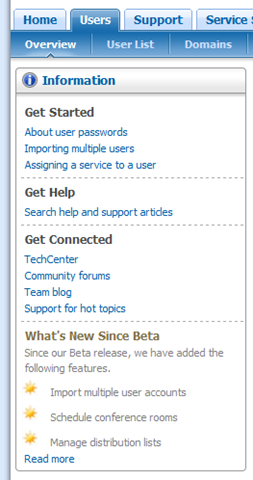
Middle panel
The front page provides you with a panel in the middle to see the current status of the services, depicted below is the Exchange Online and SharePoint Online services. There’s also a list of tasks that should be done before going live, as well as a link to download the client SSO-application.
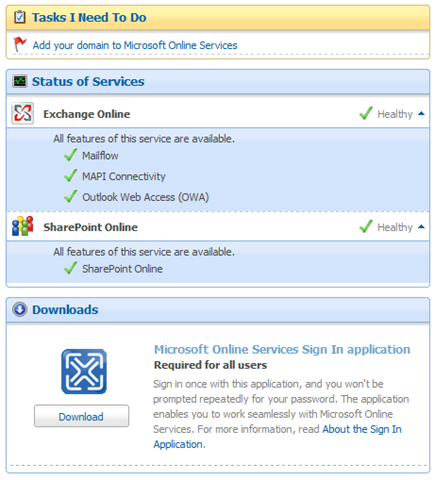
Actions panel
The Actions panel follows you along as well on a bunch of pages, providing you with alternatives for your administration – instant action.
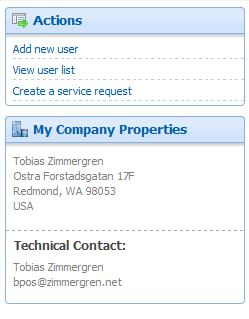
Users – Overview Administration
Licensing for Services
You will be presented with an overview of your license and the current status of it. No need to do further inventory management on lost licenses, it’s all done per auto. That’s what I’ve been waiting for, no more hassle with the licensing-jungle :-)
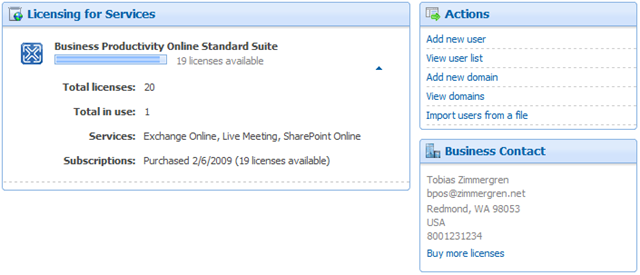
Users – User List Administration
Views
Contains a set of optional views if you’ve got plenty of users, enabling you to more easily administer them by grouping/filtering your views
User management (middle and right panels)
From the middle area of this page, you can administer all of your users and get an overview of their login-status. Using the Actions panel to the right, you can add new users, edit current users and do user-related tasks in general.
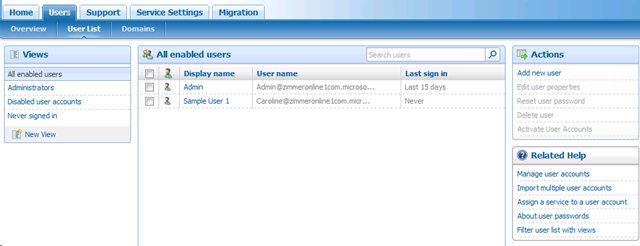
Users – Domains Administrations
Simple enough, administer your domains. More on this in an upcoming post.
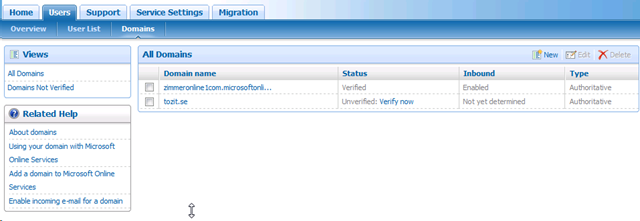
Support
On this page you will find the first and initial resources for you to use if you bump into issues and problems with your account and service. You can open new service requests from this page, and see the status of current service requests that are active.
In general terms, although it’s an service that doesn’t require any manual configurations with hardware, sort of, you always have a line of support ready for your tickets if you find that something isn’t working the way it’s supposed to. If that doesn’t help, you can always escalate the matters further.
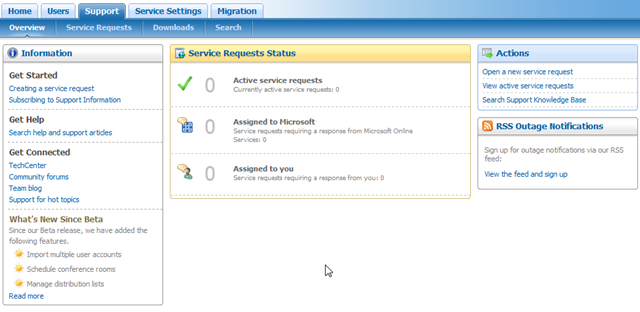
Service Settings – Overview
Now to the fun part. Under the Service Settings tab, you’ll find an overview of your usage of the services which you’ve purchased. In my case, I’m running SharePoint Online and Exchange Online – and I can see how much of the available storage I have used.
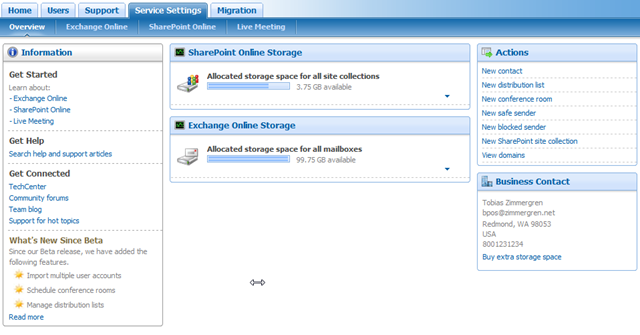
Service Settings – SharePoint Online
I’m skipping Exchange online and Live meeting, and shoots right at the target with SharePoint Online.
Basically what we see here is the first real page of our SharePoint configuration, where we can create, manage and delete site collections. Instead of Central Administration that many of you might be familiar with, this is the place you’ll need to get more familiar with to start with.

As this is just an overview post, I will save the details about creating and managing site collections for another post.
Site Settings
If you click on the "Site Settings" link, you’ll be presented with something you should be fairly familiar with – namely the Site Settings page of your site – in the cloud.
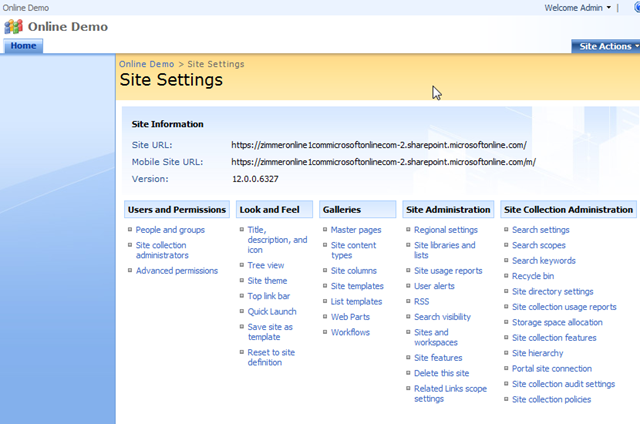
Summary
This article was nothing but an overview of the service you can use, and in the next few posts I will be talking very briefly about some of the following bullets:
- Site Administration (Creating site collections, managing site collections)
- Hooking up Exchange Online to use with your SharePoint Online platform
- Customizations using SharePoint Designer







Recent comments